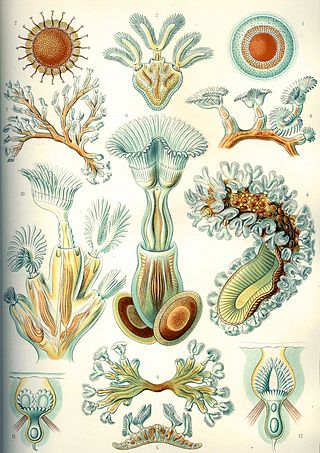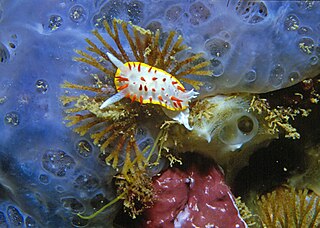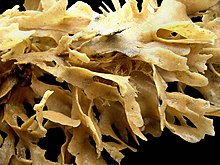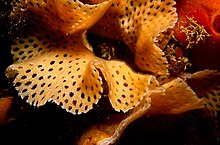
The Lophophorata are a Lophotrochozoan clade consisting of the Brachiozoa and the Bryozoa. They have a lophophore. Molecular phylogenetic analyses suggest that lophophorates are protostomes, but on morphological grounds they have been assessed as deuterostomes. Fossil finds of the "tommotiid" Wufengella suggest that they evolved from worm-like animals that resembled annelids.

Bugula is a genus of common colonial arborescent bryozoa, often mistaken for seaweed. It commonly grows upright in bushy colonies of up to 15 cm in height.
Alcyonidium hirsutum is a species of bryozoans found in shallow waters of low or fluctuating salinity, such as lagoons and estuaries. It is recognized by its surface with small papillae; when out of the water, it has a matt rather than shiny appearance.

Thecacera pennigera, common name the winged thecacera, is a species of sea slug, a nudibranch, a shell-less marine gastropod mollusc in the family Polyceridae.

Conopeum seurati is a species of colonial bryozoan in the order Cheilostomatida. It is native to the northeastern Atlantic Ocean, the North Sea and the Mediterranean Sea. This species has been introduced to New Zealand and Florida.

Antiopella cristata, sometimes known by the common name crested aeolis, is a species of nudibranch, a marine gastropod mollusc in the family Janolidae.

Bugula neritina is a cryptic species complex of sessile marine animal in the genus Bugula. It has a practically cosmopolitan distribution, being found in temperate and tropical waters around the world, and it has become an invasive species in numerous locations. It is often found in hard substrates, such as rocks, shells, pillars and ship hulls, where it can form dense mats, contributing to biofouling. B. neritina is of biomedical interest because it harbors a bacterial symbiont that produces a group of bioactive compounds with potential applications in the treatment of numerous diseases.
Paralicornia hamata is a species of gymnolaematan bryozoans first described from the Queensland coast. Originally placed in the genus Scrupocellaria, it has now been accepted within Paralicornia.
Licornia prolata is a species of gymnolaematan bryozoans first described from the Queensland coast. Originally placed in Scrupocellaria, it has now been accepted within Licornia.
Licornia peltata is a species of gymnolaematan bryozoans first described from the Queensland coast. Originally placed in Scrupocellaria, it has now been accepted within Licornia.
Licornia is a genus of gymnolaematan bryozoans.
Callopora lineata is a species of colonial bryozoan in the family Calloporidae. It is found on rocky shores in the Atlantic Ocean and the Mediterranean Sea.

Crisularia plumosa is a species of bryozoan belonging to the family Bugulidae, commonly known as the feather bryozoan. It is native to the Atlantic Ocean.
Bugulina turbinata is a species of bryozoan belonging to the family Bugulidae. It is found in shallow water in the northeastern Atlantic Ocean and the Mediterranean Sea.
Paralicornia obtecta is a species of bryozoan, found in Australian waters. It has an avicularium with three protrusions, a feature also found in Paralicornia hamata and Paralicornia sinuosa.
Paralicornia sinuosa is a species of colonial bryozoan in the Paralicornia genus, found in the Indo-Pacific region. It was originally classified as a member of the Scrupocellaria genus.
Crisia acuta is an extinct species of marine bryozoan within the family Crisiidae. It lived in the Paleogene period in southeastern Australia, with the locality being from Cape Otway. The species is distinguished by the convexity and smoothness of the zoarium in its front surface.

















